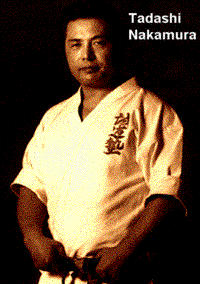Jissen Karate
READ ON ABOUT
The History and Original Idea
The Deterioration
Real Way of Empty Hand
Real Experience
Kata in Real Fights
True Karate
PICTURES OF
Mas Oyama
Tadashi Nakamura
Hideyuki Ashihara
|
Welcome to the Jissen Karate homepage. Content within this site explains the historical background of modern karate, and for a bit of judgemental value (this is my space, after all), I've included some conclusions that can only be described as personal opinions.
The History and Original Idea
The karate schools established by mainstream karate was considered 'modern' during the 1920s-1940s. Before that period, there was not a single united or organized school in Shotokan or Shito-ryu. What the Japanese knew of karate was called Tote-jitsu or Chinese-hand. In those days it was regarded as a mysterious combat skill, even in mainland Japan. In 1921, the karate master Gichin Funakoshi was invited by the Ministry of Education to introduce the art of karate to Tokyo. The demonstration turned out to be a great success. From that point onwards, karate was practiced throughout Japan, and later spread to the rest of the world.
Two Chinese schools of boxing were formerly associated with separate Okinawan schools, Shorin-ryu and Shorei-ryu. Shorei-ryu's kata (form) and techniques were deemed to be best suited for larger sized people, whereas Shorin-ryu suited the smaller sized. Modern karate masters organized and combined different katas and arranged them in sequence for different levels of practitioners, effectively introducing a new way of teaching karate.
Karate is known to some as the skill of fighting. To others, it is a practice that could kill in one blow. In fact, the practice of karate was banned during Meiji era. Because of that, the teaching of karate has always emphasized on spiritual and mental training. As Karate master Gichin Funakoshi puts it:
"True karate, that is, Karate-do, strives internally to train the mind to develop a clear conscience enabling one to face the world truthfully, while externally developing strength until one may overcome even ferocious wild animals. Mind and technique are to become one in true karate."
Under Gichin Funakoshi, Sport Karate as we know it today was non-existent. Karate practiced only kihon (basic), kata and bunkai (application of kata). The spirit of ikken hitsatsu (kill with one blow) was considered vital and emphasized under control.
I believe that the karateka (karate practitioner) at that time had the ability. Take Gichin Funakoshi as an example: his daily training included punching the makiwara (a thick post covered with rice straw) over and over, practicing kata 50 to 60 times. Gichin Funakoshi believed in perfecting one's skill through the practice of kata and bunkai.
The Deterioration
Yet Sport kumite (sparring) has been the main event and purpose from the moment it was introduced. Sadly, the introduction of Sport Karate reduced the quality of the art as karatekas tend to think that kumite in a tournament is similar to a real street fight. The original idea of kumite was to apply techniques from kata as in real fight, conversely the rules of Sport kumite prohibit many techniques taught in kata such as furi-uchi (hook), hiji-uchi (elbow strike), hiza-geri (knee kick). Body contact is disallowed and both fighters must stop when either side scores a point. Only straight punches is allowed in hand techniques.
This illusion gives the fighters no choice but to concentrate on easy score techniques. If a punch swings near the opponent's body the judge will halt the fight and bestow a point. We are made to assume that one punch could 'kill' the opponent upon contact and that the opponent did not have a chance to react. But the true fact is, no such thing was proven.
And because of this false sense, Japanese karate faced the biggest shame in losing against Thailand in 1950s. Japanese karatekas were badly beaten by the Thai boxers. The same happened in 1970s when traditional karatekas was vanquished shamefully.
Real Way of Empty hand
The lost bouts do not mean karate is vulnerable or weaker than any other martial arts. It is the failure brought on by Sport kumite, which traditional karate still blindly believe until today. I am strongly of the opinion that karatekas who train like Funakoshi would not have lost.
|


 Oyama believed karate to be the practice of bushido. It should give one the ability of jissen kumite as well as the spirit of karate. Karate is useless if it is merely beauty outside, yet devoid within.
Oyama believed karate to be the practice of bushido. It should give one the ability of jissen kumite as well as the spirit of karate. Karate is useless if it is merely beauty outside, yet devoid within.